Preparation of Citral Oleogel and Antimicrobial Properties
Abstract
:1. Introduction
2. Results and Discussion
2.1. Gel Characterization
2.1.1. Critical Gelling Concentration, Hardness and OBC
2.1.2. Fourier Transform Infrared Spectroscopy (FT-IR)
2.1.3. Crystal Morphology
2.2. Antimicrobial Activity
2.2.1. Minimum Inhibitory Concentration
2.2.2. Bacterial Growth
2.2.3. Fungal Growth
2.2.4. Airborne Microorganisms
2.2.5. Microbiological Analysis of Plant-Based Meat
3. Conclusions
4. Materials and Methods
4.1. Materials
4.1.1. Reagents
4.1.2. Strain Information
4.2. Instruments and Equipmen
4.3. Gel Characterization
4.3.1. Critical Gelling Concentration
4.3.2. Oil Binding Capacity (OBC)
4.3.3. Hardness
4.3.4. Fourier Transform Infrared Spectroscopy (FT-IR)
4.3.5. Crystal Morphology
4.4. Antimicrobial Activity
4.4.1. Minimum Inhibitory Concentration
4.4.2. In Vitro Antibacterial
4.4.3. In Vitro Antifungal
4.4.4. Resistant to Airborne Microorganisms
4.4.5. Microbiological Analysis of Plant-Based Meat
5. Statistical Analysis
Author Contributions
Funding
Institutional Review Board Statement
Informed Consent Statement
Data Availability Statement
Acknowledgments
Conflicts of Interest
References
- Sivakanthan, S.; Fawzia, S.; Madhujith, T.; Karim, A. Synergistic effects of oleogelators in tailoring the properties of oleogels: A review. Compr. Rev. Food Sci. Food Saf. 2022, 21, 3507–3539. [Google Scholar] [CrossRef]
- Limpimwong, W.; Kumrungsee, T.; Kato, N.; Yanaka, N.; Thongngam, M. Rice bran wax oleogel: A potential margarine replacement and its digestibility effect in rats fed a high-fat diet. J. Funct. Foods 2017, 39, 250–256. [Google Scholar] [CrossRef]
- Zetzl, A.K.; Marangoni, A.G.; Barbut, S. Mechanical properties of ethylcellulose oleogels and their potential for saturated fat reduction in frankfurters. Food Funct. 2012, 3, 327–337. [Google Scholar] [CrossRef] [PubMed]
- Li, L.; Liu, G.; Bogojevic, O.; Pedersen, J.N.; Guo, Z. Edible oleogels as solid fat alternatives: Composition and oleogelation mechanism implications. Compr. Rev. Food Sci. Food Saf. 2022, 21, 2077–2104. [Google Scholar] [CrossRef] [PubMed]
- Ishaq, A.; Irfan, S.; Sameen, A.; Khalid, N. Plant-based meat analogs: A review with reference to formulation and gastrointestinal fate. Curr. Res. Food Sci. 2022, 5, 973–983. [Google Scholar] [CrossRef]
- Cîrstea, N.; Nour, V.; Boruzi, A.I. Effects of Pork Backfat Replacement with Emulsion Gels Formulated with a Mixture of Olive, Chia and Algae Oils on the Quality Attributes of Pork Patties. Foods 2023, 12, 519. [Google Scholar] [CrossRef]
- Sen, C.; Rink, C.; Khanna, S. Palm Oil–Derived Natural Vitamin E α-Tocotrienol in Brain Health and Disease. J. Am. Coll. Nutr. 2010, 29, 314S–323S. [Google Scholar] [CrossRef]
- Hwang, H.S.; Singh, M.; Winkler-Moser, J.K.; Bakota, E.L.; Liu, S.X. Preparation of margarines from organogels of sunflower wax and vegetable oils. J. Food Sci. 2014, 79, C1926–C1932. [Google Scholar] [CrossRef]
- Patel, A.R.; Dewettinck, K. Edible oil structuring: An overview and recent updates. Food Funct. 2016, 7, 20–29. [Google Scholar] [CrossRef]
- Kirtane, A.R.; Karavasili, C.; Wahane, A.; Freitas, D.; Booz, K.; Le, D.T.H.; Hua, T.; Scala, S.; Lopes, A.; Hess, K.; et al. Development of oil-based gels as versatile drug delivery systems for pediatric applications. Sci. Adv. 2022, 8, eabm8478. [Google Scholar] [CrossRef]
- Sena, B.; Dhal, S.; Sahu, D.; Sarkar, P.; Mohanty, B.; Jarzębski, M.; Wieruszewski, M.; Behera, H.; Pal, K. Variations in Microstructural and Physicochemical Properties of Soy Wax/Soybean Oil-Derived Oleogels Using Soy Lecithin. Polymers 2022, 14, 3928. [Google Scholar] [CrossRef] [PubMed]
- Wang, X.; Wang, S.; Nan, Y.; Liu, G. Production of Margarines Rich in Unsaturated Fatty Acids Using Oxidative-stable Vitamin C-Loaded Oleogel. J. Oleo Sci. 2021, 70, 1059–1068. [Google Scholar] [CrossRef] [PubMed]
- Lee, M.C.; Jiang, X.; Brenna, J.T.; Abbaspourrad, A. Oleogel-structured composite for the stabilization of ω3 fatty acids in fish oil. Food Funct. 2018, 9, 5598–5606. [Google Scholar] [CrossRef] [PubMed]
- Haj Eisa, A.; Laufer, S.; Rosen-Kligvasser, J.; Davidovich-Pinhas, M. Stabilization of Ethyl-Cellulose Oleogel Network Using Lauric Acid. Eur. J. Lipid Sci. Technol. 2020, 122, 1900044. [Google Scholar] [CrossRef]
- Qiu, C.; Huang, Y.; Li, A.; Ma, D.; Wang, Y. Fabrication and Characterization of Oleogel Stabilized by Gelatin-Polyphenol-Polysaccharides Nanocomplexes. J. Agric. Food Chem. 2018, 66, 13243–13252. [Google Scholar] [CrossRef] [PubMed]
- Jiang, Z.; Geng, S.; Liu, C.; Jiang, J.; Liu, B. Preparation and characterization of lutein ester-loaded oleogels developed by monostearin and sunflower oil. J. Food Biochem. 2019, 43, e12992. [Google Scholar] [CrossRef] [PubMed]
- Fayaz, G.; Goli, S.A.H.; Kadivar, M.; Valoppi, F.; Barba, L.; Calligaris, S.; Nicoli, M.C. Potential application of pomegranate seed oil oleogels based on monoglycerides, beeswax and propolis wax as partial substitutes of palm oil in functional chocolate spread. Lwt—Food Sci. Technol. 2017, 86, 523–529. [Google Scholar] [CrossRef]
- Jiang, Z.; Lu, X.; Geng, S.; Ma, H.j.; Liu, B. Structuring of sunflower oil by stearic acid derivatives: Experimental and molecular modelling studies. Food Chem. 2020, 324, 126801. [Google Scholar] [CrossRef]
- Martins, A.J.; Cerqueira, M.A.; Pastrana, L.M.; Cunha, R.L.d.; Vicente, A.A. Sterol-based oleogels’ characterization envisioning food applications. J. Sci. Food Agric. 2019, 99, 3318–3325. [Google Scholar] [CrossRef]
- Yang, X.; Wang, T.; Tang, Y.; Shao, Y.W.; Gao, Y.-q.; Wu, P. Treatment of liver fibrosis in hepatolenticular degeneration with traditional Chinese medicine: Systematic review of meta-analysis, network pharmacology and molecular dynamics simulation. Front. Med. 2023, 10, 1193132. [Google Scholar] [CrossRef]
- Jaber, B.M.S.; Jasim, S.F. Phytochemical Study of Stigmasterol and β-sitosterol in Viola odorata Plant Cultivated in Iraq. Iraqi J. Biotechnol. 2014, 13, 86–94. [Google Scholar]
- Wang, M.; Huang, W.; Hu, Y.; Zhang, L.; Shao, Y.; Wang, M.; Zhang, F.; Zhao, Z.; Mei, X.; Li, T.; et al. Phytosterol Profiles of Common Foods and Estimated Natural Intake of Different Structures and Forms in China. J. Agric. Food Chem. 2018, 66, 2669–2676. [Google Scholar] [CrossRef] [PubMed]
- Sovová, H.; Galushko, A.A.; Stateva, R.P.; Rochova, K.; Sajfrtová, M.; Bartlová, M. Supercritical fluid extraction of minor components of vegetable oils: β-sitosterol. J. Food Eng. 2010, 101, 201–209. [Google Scholar] [CrossRef]
- Asl, P.J.; Niazmand, R.; Molaveisi, M.; Mousavi Kalajahi, S.E. Determination of vitamin E and β-sitosterol in vegetable oil wastes by graphene-based magnetic solid-phase extraction method coupled with GC-MS. J. Food Meas. Charact. 2021, 15, 5630–5636. [Google Scholar] [CrossRef]
- Shen, C.-Y.; Lee, C.-F.; Chou, W.; Hwang, J.-J.; Tyan, Y.-S.; Chuang, H.-Y. Liposomal β-Sitosterol Suppresses Metastasis of CT26/luc Colon Carcinoma via Inhibition of MMP-9 and Evoke of Immune System. Pharmaceutics 2022, 14, 1214. [Google Scholar] [CrossRef]
- Zhang, P.; Liu, N.; Xue, M.; Zhang, M.; Liu, W.; Xu, C.; Fan, Y.; Meng, Y.; Zhang, Q.; Zhou, Y. Anti-Inflammatory and Antioxidant Properties of β-Sitosterol in Copper Sulfate-Induced Inflammation in Zebrafish (Danio rerio). Antioxidants 2023, 12, 391. [Google Scholar] [CrossRef] [PubMed]
- Wu, W.; Liu, W.; Wang, H.; Wang, W.; Chu, W.; Jin, J. β-sitosterol inhibits trimethylamine production by regulating the gut microbiota and attenuates atherosclerosis in ApoE–/– mice. Front. Cardiovasc. Med. 2022, 9, 986905. [Google Scholar] [CrossRef]
- Scholz, B.; Guth, S.; Engel, K.-H.; Steinberg, P. Phytosterol oxidation products in enriched foods: Occurrence, exposure, and biological effects. Mol. Nutr. Food Res. 2015, 59, 1339–1352. [Google Scholar] [CrossRef]
- Singh, A. Sitosterol as an antioxidant in frying oils. Food Chem. 2013, 137, 62–67. [Google Scholar] [CrossRef]
- Martins, H.B.; Selis, N.d.N.; Souza, C.L.S.e.; Nascimento, F.S.; de Carvalho, S.P.; Gusmão, L.D.O.; Nascimento, J.d.S.; Brito, A.K.P.; de Souza, S.I.; de Oliveira, M.V.; et al. Anti-Inflammatory Activity of the Essential Oil Citral in Experimental Infection with Staphylococcus aureus in a Model Air Pouch. Evid.-Based Complement. Altern. Med. Ecam 2017, 2017, 2505610. [Google Scholar] [CrossRef]
- Dudai, N.; Weinstein, Y.; Krup, M.; Rabinski, T.; Ofir, R. Citral is a new inducer of caspase-3 in tumor cell lines. Planta Medica 2005, 71, 484–488. [Google Scholar] [CrossRef] [PubMed]
- Steltenkamp, R.J.; Booman, K.A.; Dorsky, J.; King, T.O.; Rothenstein, A.; Schwoeppe, E.A.; Sedlak, R.I.; Smith, T.H.; Thompson, G.R. Citral: A survey of consumer patch-test sensitization. Food Cosmet. Toxicol. 1980, 18, 413–417. [Google Scholar] [CrossRef] [PubMed]
- Wang, W.; Bao, X.; Bové, M.; Rigole, P.; Meng, X.; Su, J.; Coenye, T. Antibiofilm Activities of Borneol-Citral-Loaded Pickering Emulsions against Pseudomonas aeruginosa and Staphylococcus aureus in Physiologically Relevant Chronic Infection Models. Microbiol. Spectr. 2022, 10, e01696-22. [Google Scholar] [CrossRef]
- Mäki-Arvela, P.; Tiainen, L.-P.; Neyestanaki, A.K.; Sjöholm, R.E.; Rantakylä, T.-K.; Laine, E.; Salmi, T.; Murzin, D.Y. Liquid phase hydrogenation of citral: Suppression of side reactions. Appl. Catal. A-Gen. 2002, 237, 181–200. [Google Scholar] [CrossRef]
- Pihlasalo, J.; Klika, K.D.; Murzin, D.Y.; Nieminen, V. Conformational equilibria of citral. J. Mol. Struct.-Theochem 2007, 814, 33–41. [Google Scholar] [CrossRef]
- Gao, Y.; Wang, Z.; Xue, C.; Wei, Z. Modulation of Fabrication and Nutraceutical Delivery Performance of Ovalbumin-Stabilized Oleogel-Based Nanoemulsions via Complexation with Gum Arabic. Foods 2022, 11, 1859. [Google Scholar] [CrossRef]
- Ganguly, S.; Margel, S. Design of Magnetic Hydrogels for Hyperthermia and Drug Delivery. Polymers 2021, 13, 4259. [Google Scholar] [CrossRef]
- Yu, Y.; Wang, T.; Gong, Y.; Wang, W.; Wang, X.P.; Yu, D.; Wu, F.; Wang, L. Effect of ultrasound on the structural characteristics and oxidative stability of walnut oil oleogel coated with soy protein isolate-phosphatidylserine. Ultrason. Sonochemistry 2022, 83, 105945. [Google Scholar] [CrossRef]
- Zhan, J.; Fu, B.; Cheng, Z. Macroscopic Properties and Pore Structure Fractal Characteristics of Alkali-Activated Metakaolin–Slag Composite Cementitious Materials. Polymers 2022, 14, 5217. [Google Scholar] [CrossRef]
- Ropciuc, S.; Dranca, F.; Oroian, M.; Leahu, A.; Codină, G.G.; Prisacaru, A.E. Structuring of Cold Pressed Oils: Evaluation of the Physicochemical Characteristics and Microstructure of White Beeswax Oleogels. Gels 2023, 9, 216. [Google Scholar] [CrossRef]
- Dimakopoulou-Papazoglou, D.; Giannakaki, F.; Katsanidis, E. Structural and Physical Characteristics of Mixed-Component Oleogels: Natural Wax and Monoglyceride Interactions in Different Edible Oils. Gels 2023, 9, 627. [Google Scholar] [CrossRef] [PubMed]
- Zhao, W.; Li, Y.; Sun, T.; Yan, H.; Hao, A.; Xin, F.; Zhang, H.; An, W.; Kong, L.; Li, Y. Heat-set supramolecular organogels composed of β-cyclodextrin and substituted aniline in N,N-dimethylformamide. Colloids Surf. A Physicochem. Eng. Asp. 2011, 374, 115–120. [Google Scholar] [CrossRef]
- Shchipunov, Y.A. Lecithin organogel: A micellar system with unique properties. Colloids Surf. A Physicochem. Eng. Asp. 2001, 183, 541–554. [Google Scholar] [CrossRef]
- Noonim, P.; Rajasekaran, B.; Venkatachalam, K. Structural Characterization and Peroxidation Stability of Palm Oil-Based Oleogel Made with Different Concentrations of Carnauba Wax and Processed with Ultrasonication. Gels 2022, 8, 763. [Google Scholar] [CrossRef] [PubMed]
- Palla, C.A.; de Vicente, J.C.; Carrín, M.E.; Gálvez Ruiz, M.J. Effects of cooling temperature profiles on the monoglycerides oleogel properties: A rheo-microscopy study. Food Res. Int. 2019, 125, 108613. [Google Scholar] [CrossRef] [PubMed]
- Dassanayake, L.S.K.; Kodali, D.R.; Ueno, S.; Sato, K. Physical Properties of Rice Bran Wax in Bulk and Organogels. J. Am. Oil Chem. Soc. 2009, 86, 1163–1173. [Google Scholar] [CrossRef]
- Bot, A.; Adel, R.d.; Roijers, E.C. Fibrils of γ-Oryzanol + β-Sitosterol in Edible Oil Organogels. J. Am. Oil Chem. Soc. 2008, 85, 1127–1134. [Google Scholar] [CrossRef]
- Patel, A.R. A colloidal gel perspective for understanding oleogelation. Curr. Opin. Food Sci. 2017, 15, 1–7. [Google Scholar] [CrossRef]
- Gao, Y.; Zhang, X.; Jin, X. Preparation and Properties of Minocycline-Loaded Carboxymethyl Chitosan Gel/Alginate Nonwovens Composite Wound Dressings. Mar. Drugs 2019, 17, 575. [Google Scholar] [CrossRef]
- Chen, P.; Ference, C.M.; Sun, X.; Lin, Y.C.; Tan, L.; Zhong, T. Antimicrobial efficacy of liposome encapsulated citral and its effect on the shelf life of ‘Shatangju’ mandarin. J. Food Prot. 2020, 83, 1315–1322. [Google Scholar] [CrossRef]
- Varidi, M.; Ahmadzadeh-Hashemi, S.; Nooshkam, M. Changes in fat uptake, color, texture, and sensory properties of Aloe vera gel-coated eggplant rings during deep-fat frying process. Food Sci. Nutr. 2023, 11, 2027–2035. [Google Scholar] [CrossRef]
- Azarakhsh, N.; Osman, A.; Ghazali, H.M.; Tan, C.P.; Mohd Adzahan, N. Lemongrass essential oil incorporated into alginate-based edible coating for shelf-life extension and quality retention of fresh-cut pineapple. Postharvest Biol. Technol. 2014, 88, 1–7. [Google Scholar] [CrossRef]
- Martínez, L.; Djenane, D.; Cilla, I.; Beltrán, J.A.; Roncalés, P. Effect of different concentrations of carbon dioxide and low concentration of carbon monoxide on the shelf-life of fresh pork sausages packaged in modified atmosphere. Meat Sci. 2005, 71, 563–570. [Google Scholar] [CrossRef] [PubMed]
- Wang, Z.; Chandrapala, J.; Truong, T.; Farahnaky, A. Multicomponent Oleogels Prepared with High- and Low-Molecular-Weight Oleogelators: Ethylcellulose and Waxes. Foods 2023, 12, 3093. [Google Scholar] [CrossRef] [PubMed]
- Kanagaratnam, S.; Hoque, M.E.; Sahri, M.M.; Spowage, A. Investigating the effect of deforming temperature on the oil-binding capacity of palm oil based shortening. J. Food Eng. 2013, 118, 90–99. [Google Scholar] [CrossRef]
- Wang, S.; Liu, G. Controlled volatile release from β-sitosterol-based oleogels based on different self-assembly mechanisms. Food Chem. 2023, 425, 136506. [Google Scholar] [CrossRef]
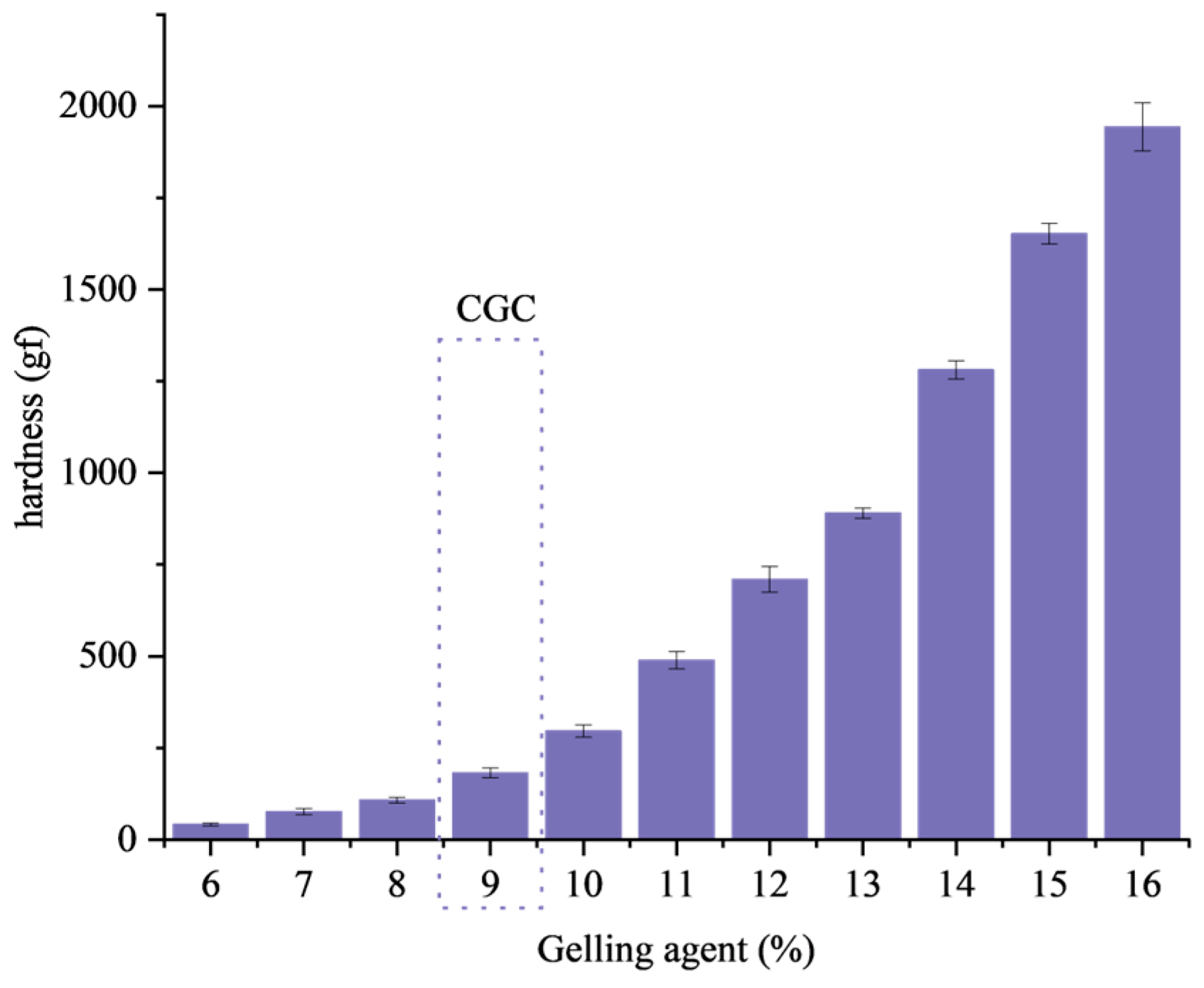
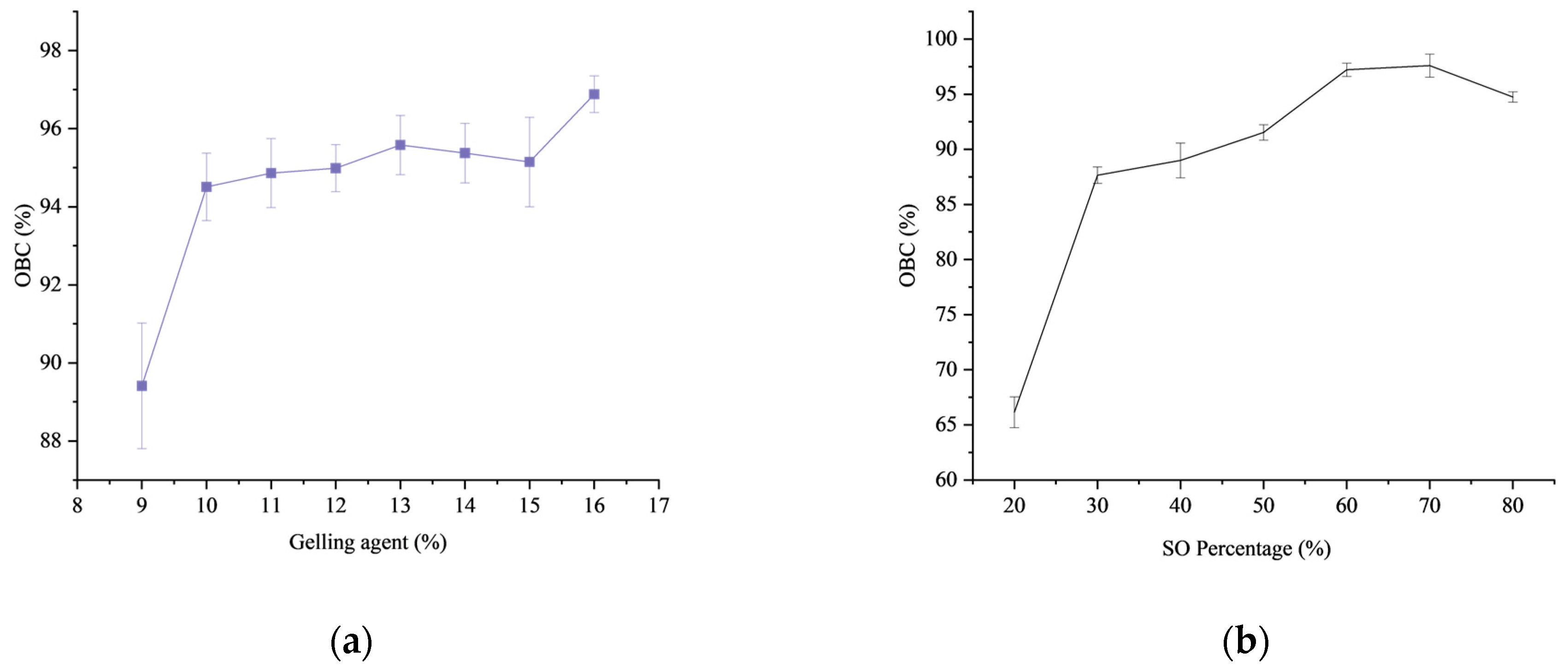
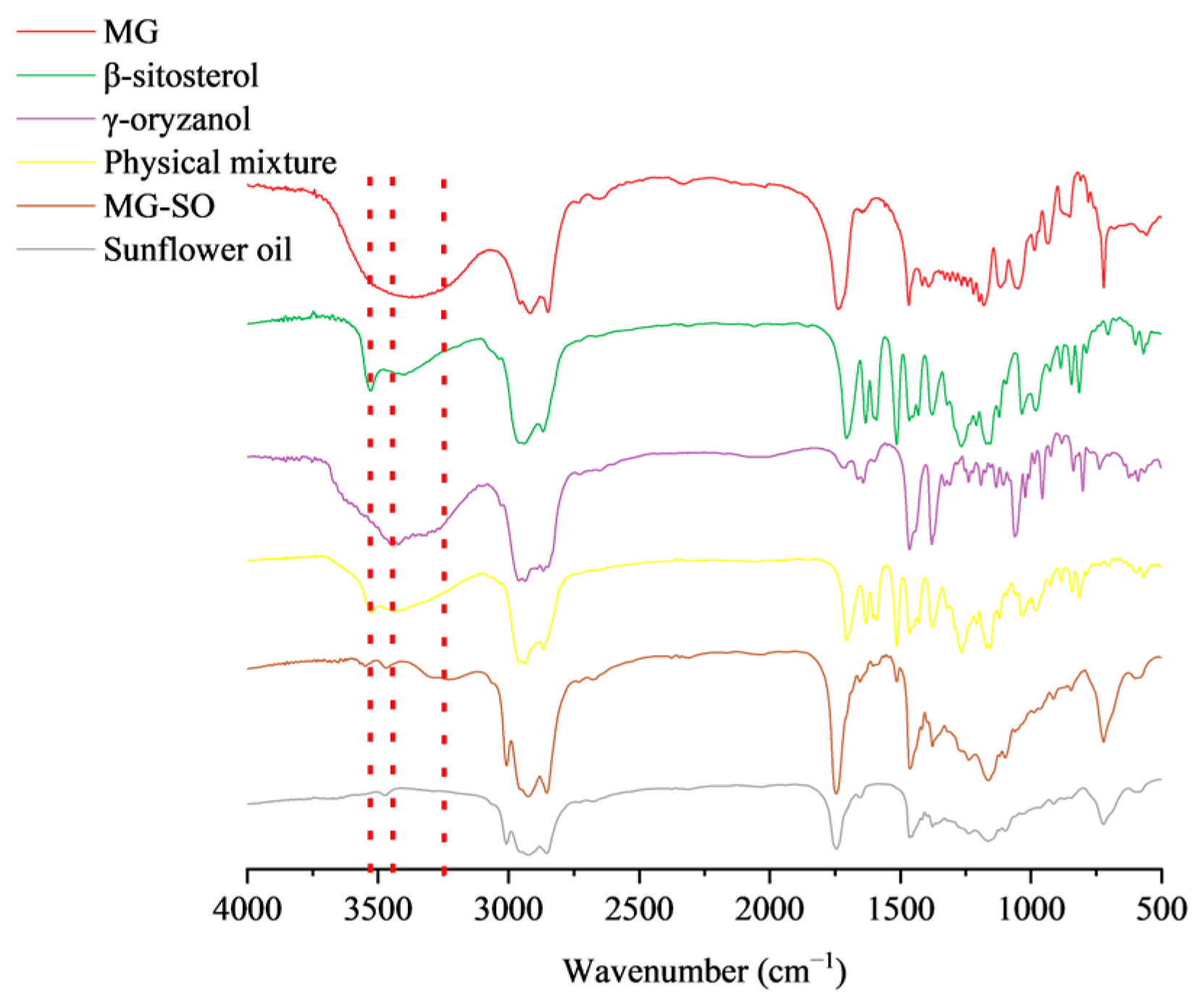
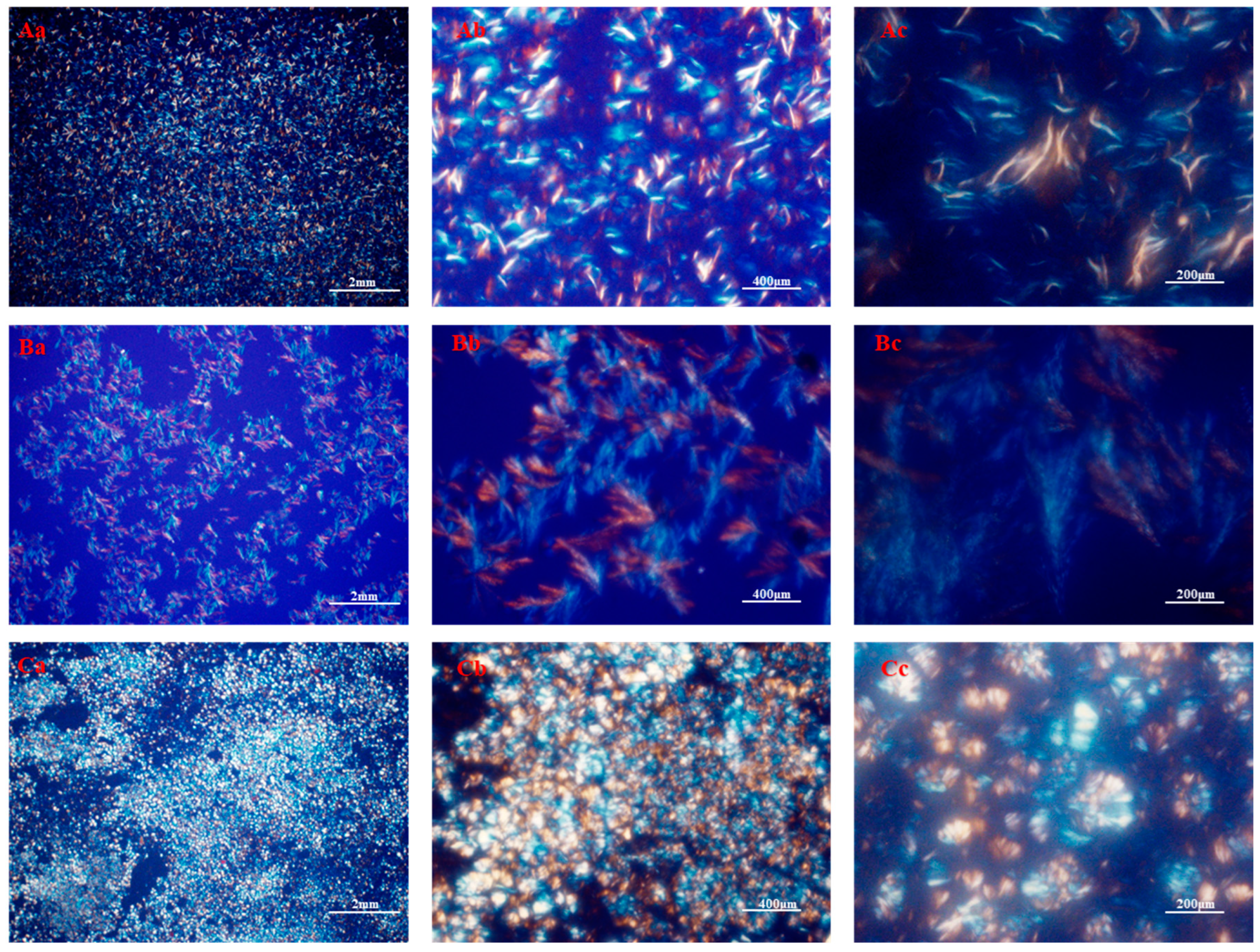
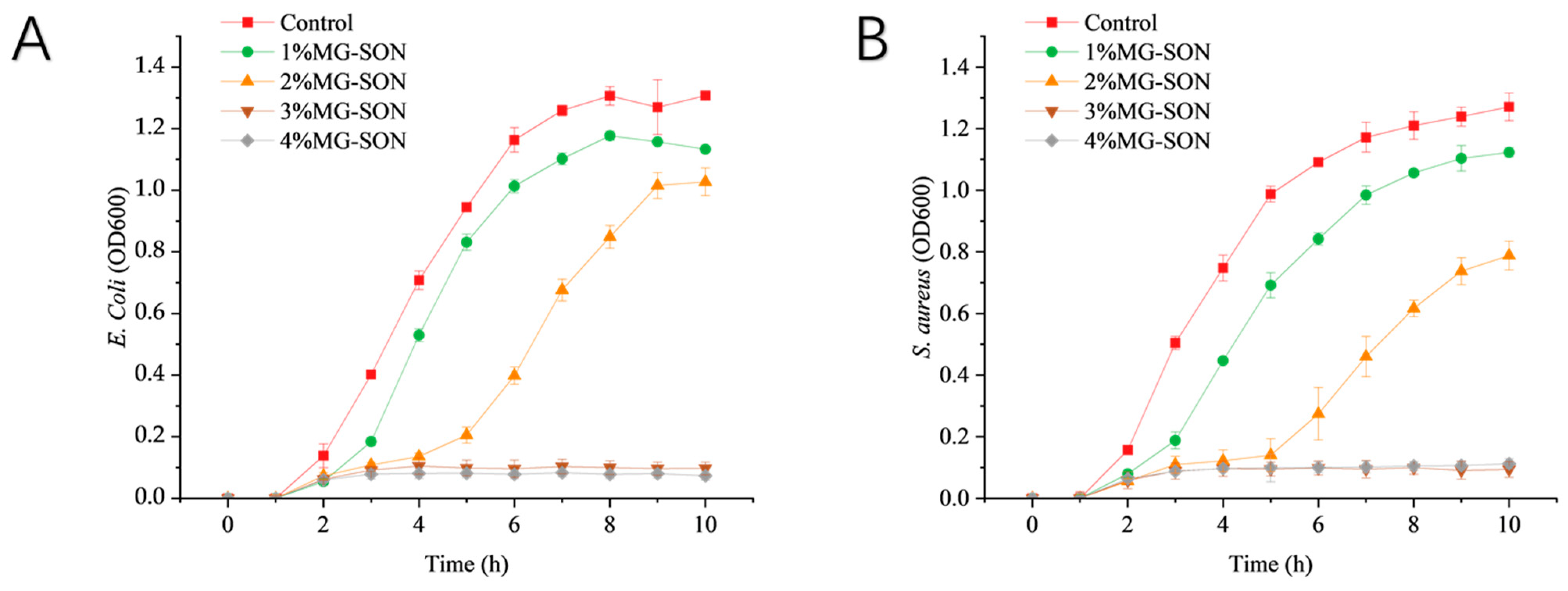


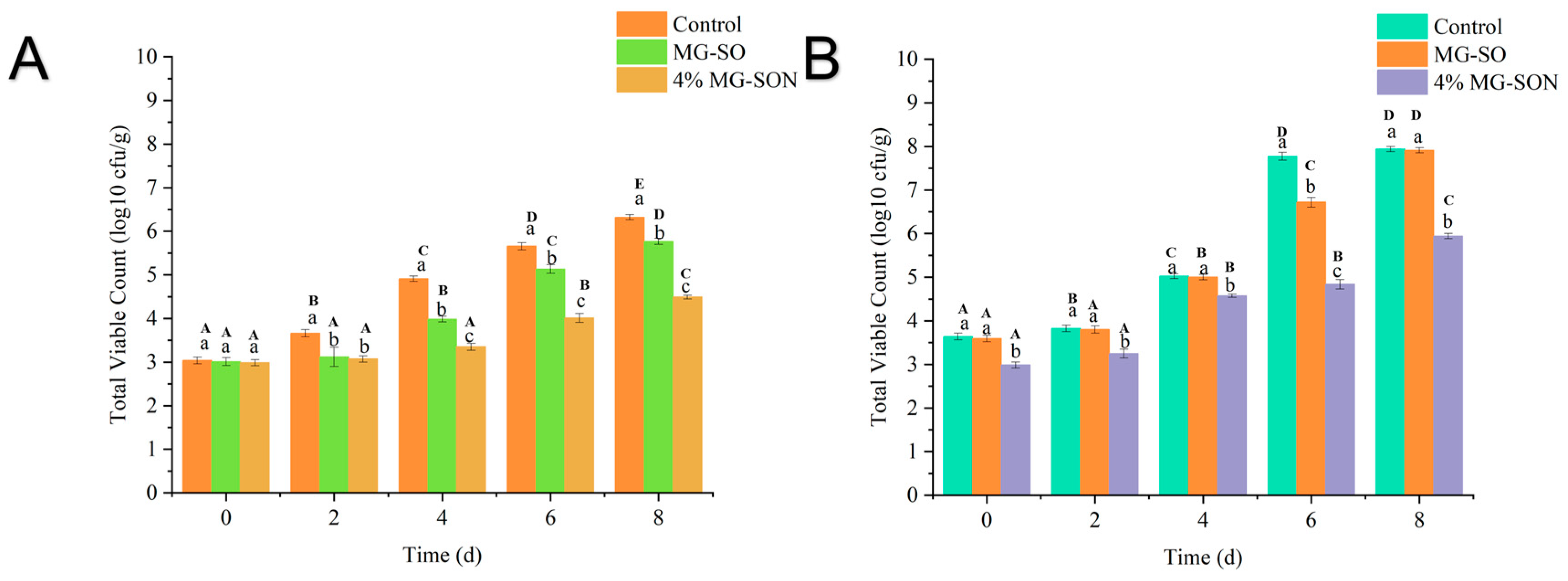
| Strain Variety | S. aureus | E. coli | Botrytis cinerea | Aspergillus niger | Rhizopus stolonifer | |
|---|---|---|---|---|---|---|
| MIC (μL/mL) | MG-SO | - | - | - | - | - |
| Citral | 3.906 | 7.812 | 15.624 | 7.812 | 15.624 | |
Disclaimer/Publisher’s Note: The statements, opinions and data contained in all publications are solely those of the individual author(s) and contributor(s) and not of MDPI and/or the editor(s). MDPI and/or the editor(s) disclaim responsibility for any injury to people or property resulting from any ideas, methods, instructions or products referred to in the content. |
© 2023 by the authors. Licensee MDPI, Basel, Switzerland. This article is an open access article distributed under the terms and conditions of the Creative Commons Attribution (CC BY) license (https://creativecommons.org/licenses/by/4.0/).
Share and Cite
Li, S.; Chen, J.; Liu, Y.; Qiu, H.; Gao, W.; Che, K.; Zhou, B.; Liu, R.; Hu, W. Preparation of Citral Oleogel and Antimicrobial Properties. Gels 2023, 9, 930. https://doi.org/10.3390/gels9120930
Li S, Chen J, Liu Y, Qiu H, Gao W, Che K, Zhou B, Liu R, Hu W. Preparation of Citral Oleogel and Antimicrobial Properties. Gels. 2023; 9(12):930. https://doi.org/10.3390/gels9120930
Chicago/Turabian StyleLi, Shangjian, Jiajia Chen, Yuntong Liu, Honghao Qiu, Wei Gao, Kundian Che, Baogang Zhou, Ran Liu, and Wenzhong Hu. 2023. "Preparation of Citral Oleogel and Antimicrobial Properties" Gels 9, no. 12: 930. https://doi.org/10.3390/gels9120930
APA StyleLi, S., Chen, J., Liu, Y., Qiu, H., Gao, W., Che, K., Zhou, B., Liu, R., & Hu, W. (2023). Preparation of Citral Oleogel and Antimicrobial Properties. Gels, 9(12), 930. https://doi.org/10.3390/gels9120930






